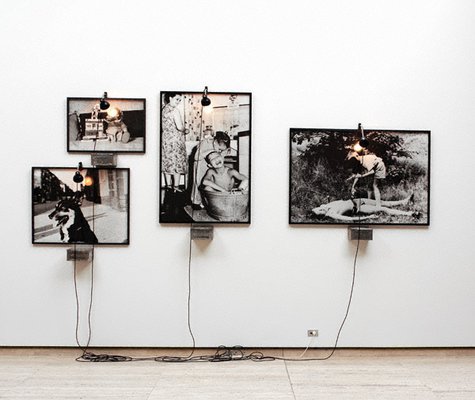


-
Details
- Date
- 1991
- Media categories
- Installation , Photograph
- Materials used
- gelatin silver photograph, biscuit box, lamp and electrical wires
- Dimensions
-
installation dimensions variable
:
a - framed photograph, 103.3 x 153.2 x 4.8 cm, frame
b - lamp and lamp cord, 37 x 10.5 x 10.5 cm, lamp
c - steel box, 12 x 23 x 22 cm
- Signature & date
Not signed. Not dated.
- Credit
- Mervyn Horton Bequest Fund 1994
- Location
- Not on display
- Accession number
- 614.1994.a-c
- Copyright
- © Estate of Christian Boltanski/ADAGP. Copyright Agency
- Artist information
-
Christian Boltanski
Works in the collection
- Share
-
-
About
Christian Boltanski grew up in post World War II France, the son of a refugee Polish Jew and a French Catholic mother. His father, who had spent many years in hiding, taught him to conceal his Jewishness to avoid persecution. Much of Boltanski’s early work reflects his memories of this time. He has also made many series of re-photographed images presumed to be of people who have died, sometimes violently. Photography is always a ‘little death’ in that the moment is captured forever yet the youth and identity of the sitter immediately begins to slip away.1
While the particular images in this installation represent children and the family dog at play, there is a brooding sadness and sense of threat which suggests that fear of loss which accompanies all our joys. The black-and-white photos are taken from, or simulate, old family snaps and sometimes news-paper images. This style is deliberate: the black-and-white prints feel like a literal trace in a way that colour plates and digital images do not. We seem to be able to sense the process embedded in the materiality of the print that is created when light falls onto silver nitrate and changes its chemical structure. In this way the light that ‘touches’ the object also touches the print. Because of this intimate process, the photo of a loved one is more than a likeness; it is a relic of their having once been there in front of the camera. This process is further enhanced by the dim reading lamp which is attached to a frame and by the old biscuit tin below each photo which suggests the collections of memorabilia that most of us have in some cupboard or shed.2 The boxes in this installation contain snapshots of the families represented in the larger photographs. The effect also suggests the use of photos in ‘ex votos’ and memorials to the departed.
In one of these images two boys are at play. One is playing dead, lying on his back in the grass, clad only in swimming briefs; the other, dressed in what could be military shorts and shirt, stoops over him, gun in hand. The time and place are not clear but could easily be wartime Germany. Is this an innocent game or is it a more sinister enactment of SS brutality by Hitler Youth? In another of the images, a German shepherd dog sits with a discarded soft toy while in another the boys are shown in an old-fashioned bath tub. The conjunction of images could convey narratives of domesticity, violence, or latent sexuality but no definitive reading is prescribed.
Boltanski plays upon the ambiguity of photography and memory by presenting these found photo-graphs from family albums or archives. In re-photographing them he further degrades the likeness and enhances the feeling of distance in time from the event. He exploits our predisposition to accept the authenticity of old black-and-white images as actual records of events yet presents them with deliberate theatrical effect. The atmosphere he creates is like that of a shrine in a cathedral or mausoleum, but it does not feel like mock religiosity – it is more personal than that and at the same time has broader cultural associations.
1. This characteristic of photography is brilliantly described in relation to photographs of Roland Barthes’ mother that he discovered after her death. Roland Barthes, ‘Camera lucida’, Richard Howard (trans), Hill and Wang, London 1981
2. Howard 1981© Art Gallery of New South Wales Contemporary Collection Handbook, 2006
-
Exhibition history
Shown in 8 exhibitions
Conversation Piece, Lisson Gallery, London, 15 Feb 1991–08 Mar 1991
Brussels Art Fair 1991, Exhibition Venue Unknown, , 26 Apr 1991–01 May 1991
NICAF 92, Yokohama, Exhibition Venue Unknown, , Mar 1992–Mar 1992
Chicago Art Fair 1994, Exhibition Venue Unknown, , 1994–1994
Art 25 Basel, Art Basel, Basel, 15 Jun 1994–20 Jun 1994
Through a Glass Darkly, Art Gallery of New South Wales, Sydney, 19 May 1995–16 Jul 1995
Ideas and Actions: Performance, Process and Documentation, Art Gallery of New South Wales, Sydney, 29 Oct 1999–23 Jan 2000
Refugees, Casula Powerhouse Arts Centre & Liverpool Regional Museum, Casula, 30 Jul 2016–11 Sep 2016
-
Bibliography
Referenced in 3 publications
-
Anthony Bond, Through a glass darkly, 'Christian Boltanski', pg. 11-18, Sydney, 1995, 18 (colour illus.).
-
Anthony Bond, Contemporary: Art Gallery of New South Wales Contemporary Collection, 'Objects and associations', pg.332-381, Sydney, 2006, 340, 341 (colour illus.).
-
Margaret Marsh, Michelle Watts and Craig Malyon, Art - art, research, theory, Melbourne, 1999, 33 (colour illus.). plate no. 4.2
-



